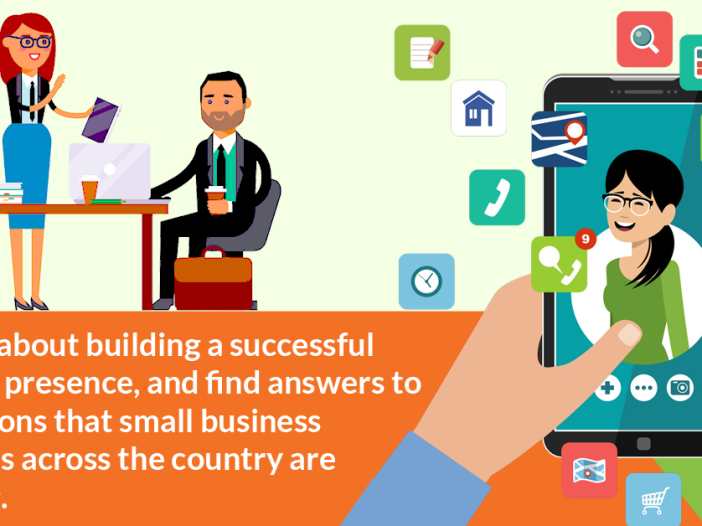
It’s cheap. It’s easy to do. And it can take less than 20 minutes to set up. Yet more than half of all small businesses still don’t have a website.
“It’s just ridiculous,” says Jim Blasingame, a small business author and radio show host. “Every small business needs a website. Period. Nonnegotiable.”
Small businesses that don’t have one say they don’t have the time, think it will cost too much or don’t want the rush of orders that comes with being online. But entrepreneurs that have jumped to the digital side say their websites have boosted sales, cut down on time-consuming phone calls and brought more people into their stores.
But not everyone wants that.
Steve Love has never had a website for the handmade sausage and meat business he’s owned since 1988. He says a website for LoveLand Farms would boost sales and he doesn’t have any more farmland to raise hogs and Black Angus cattle.
“I don’t want it to grow,” says Love, who sells his goods at a farmers’ market in Bloomington, Indiana, and a store in another town that’s open once a week. “I’m already maxed out. I’m scared it would blow up on me.”
But customers expect one. When they ask him at the farmers’ market if he has a website, he hands them a card with his phone number and a map to his shop called the Sausage Shack in Nashville, Indiana. He has no plans to start a website anytime soon. But it could happen in the future if his kids want to take over and grow the business.
“I wouldn’t say never,” says Love.
Some owners simply say they have no time.
Bill Peatman, who writes blog posts, emails and other content for websites for his corporate clients, doesn’t have one for his own business.
“I’ve just been too busy,” says Peatman, who started his Napa, California, business over a year ago. “I haven’t come up with a plan with what I want to do.”
He knows he needs one. “People don’t think you exist,” he says. “I want to grow. I want to build my own reputation and brand.”
He recently bought a domain name. And he plans to hire someone to build the site, but he thinks it will take him a few more months to get to it.
“At the way I move,” says Peatman, “about six months.”
Fifty-five percent of small businesses don’t have a website, according to a 2013 survey of more than 3,800 small businesses conducted by Internet search company Google and research company Ipsos. That’s a slight improvement from the year before, when 58 percent said they didn’t have a website.
Small business owners who want to start a website have lots of options that make it easier than in the past. Companies such as Wix.com, Google, SquareSpace.com and Weebly.com require no coding or technical skills. Users can choose a template, drag in photos and paste in words.
And with more people searching for businesses online and on their smartphones, companies without a site may be missing out on extra business.
“You might as well be a ghost,” says Blasingame, who hosts “The Small Business Advocate,” an online and nationally syndicated radio show. “The customers and opportunity pass right through you.”
Sales at Bad Pickle Tees have doubled since Cyndi Grasman began selling her quirky food-related T-shirts online a year ago. She started the business in 2012, selling shirts with sayings like “Oh Kale Yeah!” and “I Heart Bacon” at food festivals. She launched the site using website publishing company Weebly, paying $250 a year.
“I’m reaching a larger audience,” she says.
Marilyn Caskey says her website has cut down on time-consuming phone calls with customers. The owner of The Garment Exchange launched a website for her San Antonio consignment shop two years ago using a Google program. The store, which she opened in 2008, used to get calls all the time asking which clothing designers the shop resells.
“I’ll be trying to ring up a sale and someone would call,” says Caskey, who would read through a list to the caller of all the designers the store does and doesn’t buy. “Now we refer them to the website.”
Amy Gilson hopes to be able to do that soon.
She hired a company to build a website for her Oklahoma City snack food business Healthy Cravings. She is paying $4,500 for it, but she hasn’t been able to find the time to take photos and give them other information needed to finish. All customers see on EatHealthyCravings.com is a message that the site is coming soon.
“Right now, I do everything,” says Gilson. “I am the accountant, the marketer, the salesman.”
When she sells Healthy Cravings’ zucchini brownie bites or chia cookies at farmers’ markets, shoppers ask about a website. One customer, who was looking for the fat content of the snacks, took to Healthy Cravings’ Facebook page to ask if it had a website with more information.
“I can’t wait for my website,” says Gilson, who also plans to sell treats from the site. “I can just send them there.”
Written by Joseph Pisani
Recommended Reading: How Small Business Owners Are Wrecking Their Own Chances Of Success
[wp_social_sharing social_options=’facebook,twitter,googleplus,linkedin,pinterest’ facebook_text=’Share on Facebook’ twitter_text=’Share on Twitter’ googleplus_text=’Share on Google+’ linkedin_text=’Share on Linkedin’ icon_order=’f,t,g,l’ show_icons=’0′ before_button_text=” text_position=’l’ social_image=”]
